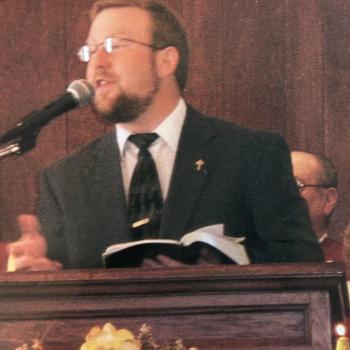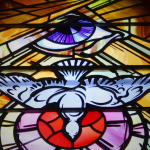I had a very uncanny experience today with the Daily Office. In a blog post this morning, I wrote, “My role is less to bring truth down to them from Mt. Sinai and more to name the truth that the Spirit is already breathing in their midst.” Well, what did God put into the Daily Office Old Testament reading today but Exodus 34:29-35 when Moses comes down from Mt. Sinai and has to put a veil over his face because he’s glowing too brightly? It made me tremble to read it because I thought God was directly confronting and contradicting what I had just blogged about. I wrote in my journal: “Teach me how to understand when I need to go to Sinai and when I need to seek Your word from my people.” But then I read the Daily Office epistle, 2 Corinthians 3:12-4:2, in which Paul uses Moses’ veil as a foil for the way in which God’s truth should be sought under Christ. And that pretty well sent me into orbit.
Since 2 Corinthians 3:12-4:2 is so profound and beautiful, it’s worth reproducing here in its entirety:
12 Since, then, we have such a hope, we act with great boldness, 13 not like Moses, who put a veil over his face to keep the people of Israel from gazing at the end of the glory that was being set aside. 14 But their minds were hardened. Indeed, to this very day, when they hear the reading of the old covenant, that same veil is still there, since only in Christ is it set aside. 15 Indeed, to this very day whenever Moses is read, a veil lies over their minds; 16 but when one turns to the Lord, the veil is removed. 17 Now the Lord is the Spirit, and where the Spirit of the Lord is, there is freedom. 18 And all of us, with unveiled faces, seeing the glory of the Lord as though reflected in a mirror, are being transformed into the same image from one degree of glory to another; for this comes from the Lord, the Spirit. 4:1 Therefore, since it is by God’s mercy that we are engaged in this ministry, we do not lose heart. 2 We have renounced the shameful things that one hides; we refuse to practice cunning or to falsify God’s word; but by the open statement of the truth we commend ourselves to the conscience of everyone in the sight of God.
This passage describes two different ways of appropriating God’s truth. In the time of Moses, God’s interaction with Israel was mediated through a single spokesperson who had absolute authority over them. Whatever Moses said was infallible. The glow in his face was a symbol of his authority and unique access to God. This understanding of truth is univocal, meaning there is one right answer — it’s whatever the guy with the veiled face says. The veil does not just protect the Israelites from being blinded by Moses’ face; it also reminds them of their lack of direct access to God. This veil would evolve over Israel’s history to become the curtain in front of the holy of holies chamber in the Jerusalem temple that only the high priest could enter at a very specific time.
If you remember from Jesus’ crucifixion story, one of the most important symbols of what His death accomplishes is the tearing of the temple curtain. Paul’s description of the community of believers in verse 18 describes the result of the liberation of God’s truth from behind Moses’ veil and the temple curtain. Instead of the glory of the Lord being the shining face of a single authoritative spokesperson, now it is reflected between multiple unveiled faces which mirror the glory of the Lord in varying degrees. So instead of being the univocal proclamation of a single prophet, truth is revealed through the symphonic interaction of a community of disciples who are all in the process of being transformed into the image of Christ.
I’ve been having a lot of conversation today about Biblical interpretation. It seems that too many Christians have an old covenant attitude about God’s revelation even though the contents of the temple scroll has been expanded to include four biographies of Jesus and a bunch of letters from Paul and other apostles. The veil that lies over their minds today is the expectation that each verse of God’s revelation is supposed to have one static, univocal meaning. Once you learn what it says, then the only thing further to do with it is to defend it against attack by heretics; otherwise there’s really no reason to read it more than once since you already know what it says.
That’s very different from the image that Paul depicts in 2 Corinthians 3:17-18 of the beautiful interaction that takes place where the Spirit of the Lord has brought freedom. It is a dynamic process by which spiritual transformation is occurring. Different people are in different places in their journey as evoked by the different “degrees of glory” that their faces radiate. And the same Bible passage can have a very different meaning for each of them because of the interaction it has with their unique spiritual journeys. In exploring the meaning together, the goal is not for one person to hegemonize everyone else to the interpretation that God has given him for this particular moment in his spiritual journey (I feel safe using the male pronoun since females don’t tend to hegemonize conversations). The point is to look for the reflection of God’s glory in each person’s perspective so that everyone can be brought into a higher degree of radiance.
If only one person’s face shines at your church, then you’re doing things the old covenant way in which the authoritative spokesperson comes down from Sinai to tell the people what the Lord has said. I cringe to think about how many churchgoers today on megachurch satellite campuses don’t even get to see a living Moses in front of them since the glowing face of the spokesperson is broadcast to them on a giant screen in front of the auditorium. Who in the world ever thought that idea was in the least bit Biblical? There’s no freedom of the Lord’s Spirit if you’re being talked at by a screen. The freedom of the Lord’s Spirit happens when your church is a dance of light radiating between multiple mirrors of Christ who grow brighter and brighter the more that they watch each other watching Jesus.















